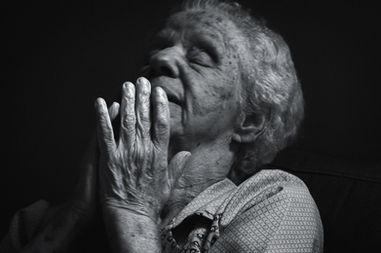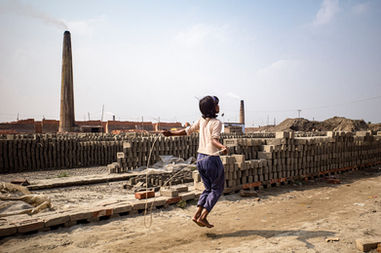
DHARAVI
Jimmy McBroom takes us inside Mumbai’s Dharavi, capturing the everyday strength of a community often reduced to stereotype. His photo essay invites us to look closer — not at poverty, but at people, lives lived with dignity, purpose, and quiet determination.
July 30, 2021
PICTORIAL STORY
photography JIMMY MCBROOM
story JIMMY MCBROOM
introduction MELANIE MEGGS
Jimmy McBroom is a social documentarian, fearlessly delving into the depths of the human experience to capture the raw and powerful moments that define us. His vivid and honest depictions of life in both Palestine and India have attracted international attention, having been used in political theatre and as part of the Sheffield Palestine Solidarity campaign. Now, Jimmy presents us with a photo essay documenting the lives of the people living in Mumbai's Dharavi Slum. This is a visual journey through the heart and soul of a place too often overlooked and forgotten by the outside world, a place where humanity and resilience thrive in spite of oppressive circumstances. Through his photographs, Jimmy offers an unflinching yet deeply human perspective on life in Dharavi — revealing not just the hardships, but the enduring spirit that defines the community.
-min.jpeg)
Dharavi is considered to be one of Asia's largest slums and has an area of just over 2.1 square kilometers and a population of around 1 million. Dharavi is one of the most densely populated areas in the world.
I spent three months in Mumbai exploring Dharavi, meeting locals and learning about the industries within. I met some of the most inspirational and resourceful people there. I witnessed happiness and community, Hindus and Muslims living together in one of the poorest and most overpopulated areas of the world. There are a lot of misconceptions about Dharavi. The media portrays Dharavi residents as 'down and outs' in films such as Slumdog Millionaire and Coldplay music videos.
This is not what I experienced.
I witnessed resourcefulness and community with limited resources. I was overwhelmed with the sense of community, ingenuity and resourcefulness of the inhabitants. With issues such as only having running water for one hour per day, a lack of any sewer system, hazardous obstacles such as live electric cables around nearly every corner of the tight mazes (which make up one of the world's largest slums), I still found Dharavi a warm magical and welcoming place to be. Maybe an example of true anarchy?
I also asked myself what has the “Western world” lost or forgotten and what could it learn from Dharavi?
The industries here not only support the residents but also help support the rest of Mumbai with rag-pickers cleaning up waste and taking it to Dharavi to be recycled. It is estimated that 80 per cent of Mumbai's solid waste is recycled into usable materials. The UK’s recycling rate was almost half that, with just under 45 per cent of household waste recycled in 2015. Other contributions to the economy of Mumbai and industries include recycling sorting centers, paint, clothing, tools, soap, wood sculpture, leather, including a handbag brand (Dharavi Handbag) sold in fashion outlets in the west, religious ornaments and many others.
It's a crucial time for Dharavi; a government development plan is threatening industries and their survival. Through talking with locals, I've learned how detrimental this scheme is. The plan currently suggests that the tower blocks are to be built over the land which currently holds these important industries. The locals are reliant on work to survive, which the slum currently provides, but the government plan does not take this into account. Jobs will be lost.
Another concern is that the foundations for the tower blocks would be unsafe as Dharavi is built on an old rubbish tip around a water pipe. There have been recent buildings and bridges collapse in Mumbai due to cheap design and foundation issues. Speaking to many residents and locals, around 95% of people are against the government scheme. Other ways of helping Dharavi would be to allow more than the 2 hours of restricted water per day (5.30am -7.30am) and better sewage and drainage systems for example.
Since leaving Dharavi, it has been in my thoughts every day. I will soon return. Obviously Covid has affected us all. Last year WHO (World Health Organization) praised Dharavi's fight against Corona. They managed to work together and flatten the curve of cases. Their strategies and working together as a community worked better than the rest of Mumbai. Door to door testing was done and fast responses to anyone with symptoms. I have remained in contact with Dharavi residents since I was there and keep in regular contact with them. Unfortunately, in recent weeks there has been a huge rise in cases and deaths all over India. Resources are completely stretched to beyond comprehension. This wave leaves Dharavi completely alone to fight an even bigger wave of Covid. Remembering Dharavi is one of the most overpopulated places on earth, with up to ten people living together in a small room, it is a breeding ground for the virus.

The people of Dharavi are the most friendly, welcoming, beautiful, resourceful, and inspiring people I have ever met. They welcomed me into their homes, fed me, educated me, and touched my heart.

The views, thoughts, and opinions expressed in the text belong solely to the author, and are not necessarily shared by The Pictorial List and the team.






































